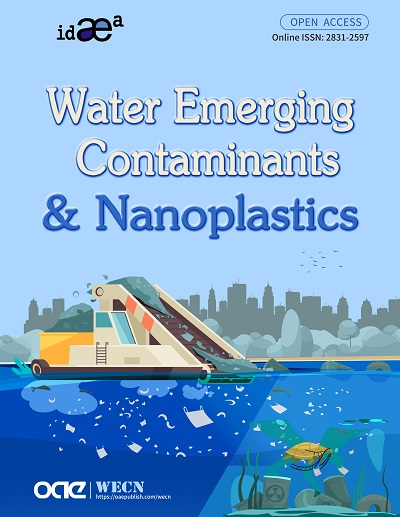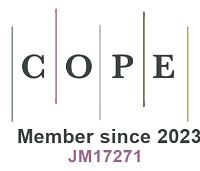Soil microplastics: we need to pay more attention
INTRODUCTION
Plastic are stable, recycled, and low-cost materials which are employed in many ways, from industrial manufacture to daily life. Plastic debris has been released into the environment due to the limited recycling frequency. It has been reported that the amount of plastic waste emitted into the environment has reached six million tons, four-fifths of which ultimately entered landfills[1]. Unfortunately, the fragmentation process does not break down plastics completely, but renders them into millions of smaller plastic particles including microplastics (MPs) with a size of < 5 mm[2,3]. Thus, studies on MP pollution have received great interest in recent years. The existence of MPs has been found in many environmental media, including atmosphere, seawater, freshwater, and even human tissues[4-7].
Soil, as an important environmental component, undertakes essential ecological functions and interacts with other environmental media simultaneously. The importation of large plastic waste and its fragments from terrestrial sources has led to the widespread presence of MPs in the aquatic environment. Therefore, the soil environment is an important “sink” of MPs[8]. The inherent complex characteristics of soil have a great impact on the environmental behavior and effects of MPs. On the one hand, MPs are prone to be transferred by organisms, posing a potential threat to organisms when the particle size reaches the nanoscale[9-11]. In addition, some inherently toxic substances, such as lubricants, pigments, and other additives, which are mainly used to improve the plastic product’s performance, pose the risk of secondary release with the natural aging process. For example, phthalate esters (PAEs) are typical plasticizers that are widely detected in manufactured products and commodities[12]. Li et al. investigated the content of PAEs in 36 vegetable fields with plastic film mulching in Shandong Peninsula, China[13]. Besides, MPs can also serve as carriers for various hazardous substances (e.g., heavy metals, pesticides, and polychlorinated biphenyls) due to the evolution of the hydrophobicity and surface functional groups, which will further increase their risk of environmental pollution[10,14]. On the other hand, the physicochemical properties of soil, including pore, pH, miners, soil animals, etc., also affect the transferring behaviors of MPs. For example, soil has mesopores and macropores in the millimeter range, whose size directly affects the migration process of MPs. Moreover, external forces such as agricultural tillage and bioturbation can also affect the migration of larger MPs in soil. Rillig et al. found that MPs can adhere to earthworms (Oligochaeta), which promotes the vertical migration of MPs in the soil; the smaller the particle size of MPs, the easier it is to migrate[15].
ANALYSIS AND DETECTION OF MPS IN SOIL
The method of MPs analysis and detection in water and sediment is suitable for the analysis and detection of MPs in soil to some extent, but it is more difficult to separate and identify MPs from soil. Sample collection mainly includes single point sampling and compound sampling. Compound sampling is suitable for agricultural soil with an uneven distribution of MPs. Single point sampling is suitable for soils with little human activity including farming[16]. Here are the analysis methods of soil MPs: (1) dry and screen soil samples; (2) remove organic matter from mixed MPs particles and soil substrate; (3) separate MPs from the soil matrix; and (4) identify and characterize the MPs in soil[17].
Among the analysis methods of MPs, the methods commonly used to characterize the physical and chemical properties of MPs include microscopic identification of MPs, spectroscopy or thermodynamic methods [Fourier transform infrared spectroscopy (FTIR), Raman spectroscopy (Raman), thermogravimetric analysis-differential scanning calorimetry, pyrolysis gas chromatography-mass spectrometry (Py-GC-MS), thermal extraction desorption gas chromatography-mass spectrometry, and scanning electron microscopy (SEM), which is often used in conjunction with energy dispersive spectroscopy (EDS)], and X-ray diffraction. These methods have their own advantages and disadvantages. The visual analysis method has the advantages of simple operation, low cost, and no chemical hazard, but the naked eye and microscope can only vaguely identify MPs through their appearance and morphology and cannot obtain the composition information of the sample. FTIR has the advantages of not destroying the sample, simple pretreatment, and no fluorescence interference, and it is widely used in the qualitative detection and composition analysis of MPs[18]. However, it is currently impossible to detect smaller MPs in the environment, and it is also difficult to analyze opaque/black MPs. In recent years, FTIR based on a focal plane array (FPA) has received increasing attention in the field of MPs analysis. Compared with FTIR, which can only analyze MPs one by one, FPA-FTIR can analyze MPs in a large area, and the efficiency has been greatly improved[19]. Raman is favored by researchers due to its significant advantages in detecting MPs such as non-destructive, low-sample-volume testing, high-throughput screening, and environmental friendliness[19]. However, biological contamination or surface aging of MPs may produce fluorescence, and fluorescent samples cannot be detected by Raman. Among the thermal analysis methods, Py-GC-MS has the risk of misidentification as different polymers may produce similar pyrolysis products. It can only analyze one particle at a time and cannot be applied to the analysis of large-scale samples in large-scale sampling and routine monitoring work[20]. In addition, thermal analysis methods are destructive to samples and can only be used for chemical characterization; they cannot obtain physical characteristics such as the size and morphology of MPs. Therefore, the thermal analysis methods need to be further optimized to become efficient and widely used MPs analysis techniques. Finally, SEM-EDS also has certain limitations, such as cumbersome sample preparation steps and time-consuming full inspection of all samples[21], resulting in low work efficiency. In addition, SEM-EDS cannot analyze the color of MPs samples, so this technique is mainly used to analyze specific MPs.
Overall, there are still many problems to be solved with the current MP analytical detection methods. Since there is no standardized detection method for MP analysis, the abundance of MPs detected in different studies varies widely. Variability occurs not only at the upper limit of MP size but also at the lower limit. There are various reasons for this to happen. Firstly, in some cases, the soil needs to be sieved to 2 mm. However, if applied to MP analysis, this procedure will lose some MPs, resulting in a decrease in their abundance. Secondly, the use of different salts has advantages and disadvantages when extracting MPs by density separation. In addition, after pretreatment, the MPs need to be filtered onto the membrane. However, different studies use different membrane apertures, which also leads to changes in the abundance of MPs[22].
In summary, in recent years, MP analysis methods have developed rapidly, but they still cannot fully solve the problems faced when studying MPs in soil and other complex environmental substrates. To comprehensively compare the occurrence of MPs in soil from different research regions, it is necessary to establish standard and uniform MP analysis and testing methods. In addition, MP concentration reporting data must be representative, scientific, and reproducible.
ABUNDANCE OF MPS IN SOIL
Although the occurrence and distribution of soil MPs are still not the focus of current research, existing studies indicate that MP pollution exists in soils around the world[23]. Researchers examined MPs in soils from coastal Shandong province, China, and recorded the abundance of MPs as ranging from 1.3 to 14,712.5 items/kg[24]. Agricultural soils are mainly studied in inland areas, where MPs are mainly derived from improper disposal of agricultural plastic film. A study on farmland soil in the suburbs of Harbin, Heilongjiang province, found a low-density abundance of 107 items/kg[25]. MPs have also been detected in agricultural areas in northern China, such as soil in Tianjin (95 items/kg), the Loess Plateau Region (40-320 items/kg), and Shaanxi province (1430-3410 items/kg)[26-28]. MPs have even been detected in farmland on the Tibetan Plateau without direct anthropogenic plastic pollution, with an abundance between 20 and 110 items/kg[29].
Extensive research on MPs has been conducted in soils around the world. The mean abundance of MPs was 306 and 184 items/kg in farmland and pasture soils collected from the Chilean metropolitan area[30]. A similar abundance of MPs (593 items/kg) has been reported in a Swiss floodplain wetland soil[31]. The problem of MP pollution caused by the long-term application of sludge is attracting attention. The abundance of MPs reaches 600-10,400 items/kg in Mellipilla, Chile, where sludge has been continuously applied[32].
Currently, there are few studies on the distribution of MPs in global soils. The range of MP abundances reported from various countries varies dramatically, mainly because not all MPs in soils were detected due to the lack of uniform research methods. In addition, a convertible method needs to be established between the expression methods of quantity (items/kg) and mass (mg/kg). In the future, a unified and comparable research method needs to be established to standardize the expression of MP abundance.
BEHAVIOR OF MPS IN SOIL
There are many sources of MPs in soil. The main sources include agricultural plastic film residues, land use of sewage sludge, long-term application of organic fertilizers, surface runoff and irrigation, and atmospheric deposition. MPs entering the soil environment have complex migration behaviors, which could undergo diffusion and migration under the action of wind, soil organisms, surface runoff, gravity, etc. Some MPs may enter the ground under the action of soil animals[33,34], microorganisms[35], plant roots[36,37], or gravity, then enter the freshwater environment through underground runoff, and eventually accumulate in the ocean. Other MPs, which remain on the surface, may enter freshwater under the action of wind[38] or surface runoff[39,40], and then may migrate over a long distance to the ocean. Soil MPs may also be transported into the air by wind and dust[41]. Animals in soil and sea could feed on MPs and pass them on[42], and MPs could also be absorbed and accumulated by plants[43], which could ultimately allow MPs to enter the food chain and cause unpredicted risks to human health. In addition, due to the hydrophobicity and large specific surface area of MPs, they can adsorb various pollutants (such as heavy metals, antibiotics, pesticides, polycyclic aromatic hydrocarbons, etc.) and can be used as a carrier or transport medium for these pollutants and pathogens, which in turn affects their migration and distribution in the environment[10,14]. Along with these properties, MPs are inherently toxic, which is mainly due to the addition of toxic substances such as plasticizers, flame retardants, colorants, antioxidants, and light and heat stabilizers during plastic processing[44,45]. As plastics undergo mechanical wear, photodegradation, photooxidation, thermal oxidation, and biodegradation in soil, these substances can be released into the environment[46,47]; moreover, it is possible to form nanoplastics with larger specific surface area, stronger fluidity, and easier ingestion by organisms[40], threatening ecosystems and human health. These reasons lead MPs to be viewed as a combination of various pollutants, while the bioavailability of MPs and other pollutants by soil organisms, and their combined toxicity, may be different from individual pollutants, potentially posing additional or greater risks to soil ecosystems and human health.
EFFECTS OF MPS ON SOIL QUALITY
As a common solid pollutant, MPs may change the basic physical and chemical properties of soil, including soil structure[48], soil density[49], soil water infiltration rate[50], and soil nutrient element utilization[51]. When MPs enter the soil, due to the intervention of new cementing substances, the isoelectric coagulation Coulomb force and van der Waals force between soil particles and their biochemical environment are changed, which may affect the formation and process of soil aggregates. Machado studied the impact of four common MPs on soil structure and found that polyester reduced soil water-stable aggregates, while PE caused the opposite effect. The reduction of soil water-stable aggregates weakens the diversity of the soil microenvironment[52]. Once incorporated into the soil matrix, MPs change the size of soil porosity, soil water dynamics, and the formation of soil aggregates. Related studies have shown that, after adding polyester microfibers to cohesive soils, water-stable macro-aggregates and pore volume significantly increase[53]. The density of most MPs is lower than soil minerals, which may be the reason for the changes in soil bulk density caused by MP pollution[49]. The presence of MPs can also damage the integrity of the soil structure, leading to drying and cracking of the soil surface[48]. Besides, MPs have prominent effects on soil organic carbon or nitrogen cycling. Previous studies have shown that, under the comprehensive action of soil organic matter, minerals, organisms, and other complex environmental factors, MPs can have significantly enhanced adsorption capacity for some heavy metal ions and organic pollutants after entering the soil, thus affecting the soil nutrient availability and soil ecosystem health[54]. However, one study concluded that the addition of MPs poses no obvious harm to soil quality, based on the finding that soil saturated hydraulic conductivity and bulk density were not dramatically affected by ultrafine polyester fibers[53].
EFFECTS OF MPS ON SOIL ORGANISMS
There are many living organisms in the soil system, including microorganisms, animals, and plants. They are of great significance to maintaining a certain range of soil ecological stability[55,56]. As an exogenous substance, MPs affect the soil properties after entering the soil, thereby causing disturbance to the balance of the ecosystem[36]. This may lead to greater environmental stress and the abnormal growth of the organisms and plants in the soil. In addition, MPs can absorb toxic pollutants in soil and cause more pollutants to accumulate in soil organisms, which will change the bioavailability of pollutants[57]. Thus, if MPs are ingested by organisms, they may be toxic to the organisms and enter the food chain, resulting in great environmental risks.
Effect of MPs on microorganisms
MPs, as exogenous materials, provide a new ecological habitat for microorganisms after entering the soil, and the microbial community that grows on MPs is also called a “plastic circle”[58]. The microbial communities growing on MPs are significantly different from the plastic and the surrounding environment. For example, the agricultural PE microfilm surface is enriched in some taxa, such as Actinobacteria, Bacteroidetes, and Proteobacteria in farmland soil, as a “special microbial accumulator”[59]. The microbial community in soil with PEMPs was significantly different from those in the soil without PEMPs[60]. Soil porosity and moisture can also be changed by MPs, thereby affecting the distribution of different microorganisms and even resulting in the destruction of microhabitats and the extinction of some microorganisms[61,62]. MPs in the soil environment may accumulate a lot of organic matter or heavy metal pollutants, such as pesticides and metals, e.g., copper, which might inhibit microbial growth[63]. Antibiotic resistance genes (ARGs) in soil environments have also attracted extensive public attention in recent years[64-66]. Existing studies have shown that MPs in the soil can enrich ARGs in soil. Song et al. found that the presence of MPs not only increased the content of ARGs in soil but also increased the content of ARG-containing hosts in Pseudomonas[67]. This increases the risk of horizontal transfer of ARGs in microbial communities formed on MPs. Although MPs can adversely affect soil microorganisms, some microorganisms in soil can also promote the degradation of specific types of MPs; for example, Cladosporium cladosporioides, Xepiculopsis graminea, Penicillium griseofulvum, and leptophaeria sp could all promote the degradation of polyurethane (PU)[68].
Effect of MPs on animals
Besides microorganisms, previous studies have demonstrated that the presence of MPs has a great impact on soil animals. MPs may be ingested by soil animals to enter the soil food chain and continuously accumulate, thus affecting the total nutrients level of the soil[42]. When exposed to MPs, the feeding behavior of soil animals is altered[69], which affects the metabolism of carbon and nitrogen uptake, leading to decreased development and even death[69,70]. Many studies have shown that earthworms might ingest MPs, causing intestinal damage, which affects their survival, growth, and reproduction[10,71-72]. In addition, the negative effects of MPs on several soil invertebrates (e.g., springtails, nematodes, collembola, and snails) have been demonstrated in previous work[73]. The adverse effects of MPs on soil animals were related to the particle size and concentration of MPs. For example, Selonen et al. found that long fiber MPs concentrations of 0.17% and 0.5% decreased the reproduction of E. crypticus by 20%; when the concentration increased to 1.5%, the reproduction decreased by 30%[72]. Lei et al. found that the excitability and toxicity of C. elegans behavior were related to the size of MPs, and they deteriorated as the size of the MPs decreased[74]. In addition to the MPs themselves, the additives in plastics also significantly affect and poison the growth and survival rate of the host as well as the intestinal flora[75]. Behaviors of soil animals, such as crawling, scraping, chewing, and excretion, can lead to vertical and horizontal migration of MPs in soil[56].
Effect of MPs on plants
The effect and damage of MPs to plants are also multifaceted, because of the diversity of MPs and the mechanisms of MPs and plants. It can be summarized in two ways: (1) directly changing the physiological and biochemical properties of plants through the roots; and (2) changing the physicochemical properties or biological conditions of the soil to indirectly affect the growth of plants[62,76-77]. The toxicity of MPs to plants after being absorbed by plants is related to other pollutants bound to MPs, such as organic or heavy metal pollutants[78]. In addition, MPs are further aged in the soil and their additives are directly toxic to plants[46]. Numerous studies have demonstrated the adverse effects of exposure to soil MPs on plants, especially crops, including inhibition of seed germination and plant growth, reduction in biomass, interference with metabolism, and genotoxicity[76,79-81]. However, in recent years, some MPs have also been found to promote plant growth. For example, Shi et al. found that PEMPs significantly improved the biomass growth rates of sweet potatoes by adsorbing more available P and K in the soil[77]. Rillig et al. indicated that the potential positive and negative mechanisms of MPs to plants were related to the plant species. In summary, the interaction between MPs in soil and plants is very complex and needs to be further studied in the future[82].
CONCLUSIONS AND PROSPECTS
As a global problem, soil MP pollution has become the focus of research by scholars around the world. Their environmental behavior not only affects soil properties, crop growth, microbial activity, animals, etc. but also may pose serious threats to human health. At present, the research on soil MPs is not systematic and comprehensive enough, and some systematic thinking and research are needed. Here, we put forward several prospects for future research:
(1) Separation and detection of MPs in soil: At present, the separation and detection methods of MPs in soil are limited and different, so it is difficult to compare horizontally. In addition, nanoscale plastics are neglected and difficult to separate and extract. It is difficult to accurately analyze and judge the overall abundance and pollution degree of MPs in soil. Therefore, it is urgent to establish a standardized and structurally damage-free MP separation and detection method.
(2) Environmental health risk assessment of soil MPs and their additives: MPs contain plasticizers such as phthalates (PAEs), which are not covalently bound to the polymer and may leach during the chemical and non-chemical aging of the plastic. Therefore, it remains unclear whether the environmental behavior and risks of MPs are due to the particle effect of MPs, the chemical effect of plastic additives, or the effect of combined pollution.
(3) Control and reduction of soil MPs: Soil MPs will bring a series of risks to the ecosystem. Therefore, soil microplastic pollution remediation needs to be carried out through source control or indirect reduction. To mitigate the risk of MP pollution from the perspective of source control, environmentally friendly biodegradable plastics have been widely promoted and used as substitutes for non-degradable plastics, but there is a lack of research on their possible ecological and environmental effects during the process of biodegradation, requiring further exploration. For the indirect reduction process of MPs, biodegradation and abiotic processes, synergistic removal with other pollutants, and synergistic operation with agricultural production should be taken into consideration.
(4) Food chain transmission mechanism and risk research of soil MPs: MPs ingested by soil animals can be transmitted to the human body through the food chain; however, due to ethical restrictions, little is known about the transmission mechanism of MPs entering the human body and their risk effects on human tissues and organs. Subsequent studies should be carried out through in vitro cell models.
DECLARATIONS
Authors’ contributionsMade a substantial contribution to conceptualization, supervision, writing original draft, reviewing and editing: Guo X
Made a substantial contribution to writing original draft: Cui Q, Ma S, Xiao C, Yang Z
Availability of data and materialsNot applicable.
Financial support and sponsorshipThe study was supported by the National Natural Science Foundation of China (No. 41977307).
Conflicts of interestAll authors declared that there are no conflicts of interest.
Ethical approval and consent to participateNot applicable.
Consent for publicationNot applicable.
Copyright© The Author(s) 2022.
REFERENCES
1. Ding L, Huang D, Ouyang Z, Guo X. The effects of microplastics on soil ecosystem: a review. Current Opinion in Environmental Science & Health 2022;26:100344.
3. Pellini G, Gomiero A, Fortibuoni T, et al. Characterization of microplastic litter in the gastrointestinal tract of Solea solea from the Adriatic Sea. Environ Pollut 2018;234:943-952.
4. Ding J, Sun C, He C, et al. Atmospheric microplastics in the Northwestern Pacific Ocean: distribution, source, and deposition. Sci Total Environ 2022;829:154337.
5. Leslie HA, van Velzen MJM, Brandsma SH, et al. Discovery and quantification of plastic particle pollution in human blood. Environ Int 2022;163:107199.
6. Niu L, Li Y, Li Y, Hu Q, Wang C. New insights into the vertical distribution and microbial degradation of microplastics in urban river sediments. Water Res 2021;188:116449.
7. Zhang W, Zhang S, Wang J, et al. Microplastic pollution in the surface waters of the Bohai Sea, China. Environ Pollut 2017;231:541-548.
8. Nobre CR, Santana MFM, Maluf A, et al. Assessment of microplastic toxicity to embryonic development of the sea urchin Lytechinus variegatus (Echinodermata: Echinoidea). Mar Pollut Bull 2015;92:99-104.
9. Hurley RR, Nizzetto L. Fate and occurrence of micro(nano)plastics in soils: knowledge gaps and possible risks. Current Opinion in Environmental Science & Health 2018;1:6-11.
10. Huerta Lwanga E, Gertsen H, Gooren H, et al. Microplastics in the terrestrial ecosystem: implications for lumbricus terrestris (Oligochaeta, Lumbricidae). Environ Sci Technol 2016;50(5):2685-2691.
11. Qiang L, Cheng J. Exposure to polystyrene microplastics impairs gonads of zebrafish (Danio rerio). Chemosphere 2021;263:128161.
12. Staples CA, Peterson DR, Parkerton TF, Adams WJ. The environmental fate of phthalate esters: a literature review. Chemosphere 1997;35:667-749.
13. Li K, Ma D, Wu J, Chai C, Shi Y. (2016) Distribution of phthalate esters in agricultural soil with plastic film mulching in Shandong Peninsula, East China. Chemosphere 2016;164:314-321.
14. Guo X, Wang X, Zhou X, et al. Sorption of four hydrophobic organic compounds by three chemically distinct polymers: role of chemical and physical composition. Environ Sci Technol 2012;46:7252-7259.
15. Rillig MC, Ingraffia R, de Souza Machado AA. Microplastic incorporation into soil in agroecosystems. Front Plant Sci 2017;8:1805.
16. Cao J, Zhao X, Gao X, et al. Extraction and identification methods of microplastics and nanoplastics in agricultural soil: A review. J Environ Manage 2021;294:112997.
17. Moller JN, Loder MGJ, Laforsch C. Finding microplastics in soils: a review of analytical methods. Environ Sci Technol 2020;54:2078-2090.
18. Jin N, Song Y, Ma R, et al. Characterization and identification of microplastics using Raman spectroscopy coupled with multivariate analysis. Anal Chim Acta 2022;1997:339519.
19. Tirkey A, Upadhyay LSB. Microplastics: an overview on separation, identification and characterization of microplastics. Mar Pollut Bull 2021;170:112604.
20. Löder MGJ, Kuczera M, Mintenig S, Lorenz C, Gerdts G. Focal plane array detector-based micro-Fourier-transform infrared imaging for the analysis of microplastics in environmental samples. Environ Chem 2015;12:563-581.
21. Fu W, Min J, Jiang W, Li Y, Zhang W. Separation, characterization and identification of microplastics and nanoplastics in the environment. Sci Total Environ 2020;721:137561.
22. He D, Luo Y, Lu S, et al. Microplastics in soils: analytical methods, pollution characteristics and ecological risks. TrAC Trends in Analytical Chemistry 2018;109:163-172.
23. Yang L, Zhang Y, Kang S, Wang Z, Wu C. Microplastics in soil: a review on methods, occurrence, sources, and potential risk. Sci Total Environ 2021;780:146546.
24. Zhou Q, Zhang H, Fu C, et al. The distribution and morphology of microplastics in coastal soils adjacent to the Bohai Sea and the Yellow Sea. Geoderma 2018;322:201-208.
25. Zhang S, Liu X, Hao X, Wang J, Zhang Y. Distribution of low-density microplastics in the mollisol farmlands of northeast China. Sci Total Environ 2020;708:135091.
26. Ding L, Zhang S, Wang X, et al. The occurrence and distribution characteristics of microplastics in the agricultural soils of Shaanxi Province, in north-western China. Sci Total Environ 2020;720:137525.
27. Han X, Lu X, Vogt RD. An optimized density-based approach for extracting microplastics from soil and sediment samples. Environ Pollut 2019;254:113009.
28. Zhang S, Yang X, Gertsen H, et al. A simple method for the extraction and identification of light density microplastics from soil. Sci Total Environ 2018;616-617:1056-1065.
29. Feng S, Lu H, Tian P, et al. Analysis of microplastics in a remote region of the Tibetan Plateau: implications for natural environmental response to human activities. Sci Total Environ 2020;739:140087.
30. Corradini F, Casado F, Leiva V, Huerta-Lwanga E, Geissen V. Microplastics occurrence and frequency in soils under different land uses on a regional scale. Sci Total Environ 2021;752:141917.
31. Scheurer M, Bigalke M. Microplastics in Swiss floodplain soils. Environ Sci Technol 2018;52:3591-3598.
32. Corradini F, Meza P, Eguiluz R, et al. Evidence of microplastic accumulation in agricultural soils from sewage sludge disposal. Sci Total Environ 2019;671:411-420.
34. Yu M, van der Ploeg M, Huerta Lwanga E, et al. Leaching of microplastics by preferential flow in earthworm (Lumbricus terrestris) burrows. Environ Chem 2019;16:31-40.
35. Bradney L, Wijesekara H, Palansooriya KN, et al. Particulate plastics as a vector for toxic trace-element uptake by aquatic and terrestrial organisms and human health risk. Environ Int 2019;131:104937.
36. Guo J, Huang X, Xiang L, et al. Source, migration and toxicology of microplastics in soil. Environ Int 2020;137:105263.
37. Li H, Lu X, Wang S, Zheng B, Xu Y. Vertical migration of microplastics along soil profile under different crop root systems. Environ Pollut 2021;278:116833.
38. Rezaei M, Riksen MJPM, Sirjani E, Sameni A, Geissen V. Wind erosion as a driver for transport of light density microplastics. Sci Total Environ 2019;669:273-281.
39. Horton AA, Walton A, Spurgeon DJ, Lahive E, Svendsen C. Microplastics in freshwater and terrestrial environments: evaluating the current understanding to identify the knowledge gaps and future research priorities. Sci Total Environ 2017;586:127-141.
40. Zhao S, Zhang Z, Chen L, et al. Review on migration, transformation and ecological impacts of microplastics in soil. Appl Soil Ecol 2022;176:104486.
41. Dris R, Gasperi J, Mirande C, et al. A first overview of textile fibers, including microplastics, in indoor and outdoor environments. Environ Pollut 2017;221:453-458.
42. Rillig MC. Microplastic in terrestrial ecosystems and the soil? Environ Sci Technol 2012;46:6453-6454.
43. Kaiser D, Kowalski N, Waniek JJ. Effects of biofouling on the sinking behavior of microplastics. Environ Res Lett 2017;12:124003.
44. Ren Z, Gui X, Xu X, et al. Microplastics in the soil-groundwater environment: aging, migration, and co-transport of contaminants-a critical review. J Hazard Mater 2021;419:126455.
45. Zhu F, Yan Y, Doyle E, et al. Microplastics altered soil microbiome and nitrogen cycling: the role of phthalate plasticizer. J Hazard Mater 2022;427:127944.
46. Hahladakis JN, Velis CA, Weber R, Iacovidou E, Purnell P. An overview of chemical additives present in plastics: migration, release, fate and environmental impact during their use, disposal and recycling. J Hazard Mater 2018;344:179-199.
47. Luo H, Li Y, Zhao Y, et al. Effects of accelerated aging on characteristics, leaching, and toxicity of commercial lead chromate pigmented microplastics. Environ Pollut 2020;257:113475.
48. Wan Y, Wu C, Xue Q, Hui X. Effects of plastic contamination on water evaporation and desiccation cracking in soil. Sci Total Environ 2019;654:576-582.
49. de Souza Machado AA, Lau CW, Till J, et al. Impacts of microplastics on the soil biophysical environment. Environ Sci Technol 2018;52:9656-9665.
50. Zhang D, Ng EL, Hu W, Wang H, Galaviz P, et al. Plastic pollution in croplands threatens long-term food security. Glob Chang Biol 2020;26:3356-3367.
51. Liu H, Yang X, Liu G, et al. Response of soil dissolved organic matter to microplastic addition in Chinese loess soil. Chemosphere 2017;185:907-917.
52. de Souza Machado AA, Lau CW, Kloas W, et al. Microplastics can change soil properties and affect plant performance. Environ Sci Technol 2019;53:6044-6052.
53. Zhang G, Zhang F, Li X. Effects of polyester microfibers on soil physical properties: perception from a field and a pot experiment. Sci Total Environ 2019;670:1-7.
54. Zhou Q, Zhang H, Yuan L, Luo Y. Progress on microplastics pollution and its ecological effects in the coastal environment. Chinese Sci Bull 2015;60(33):3210.
55. Joos L, De Tender C. Soil under stress: The importance of soil life and how it is influenced by (micro)plastic pollution. Comput Struct Biotechnol J 2022;20:1554-1566.
56. Zhang Y, Zhang X, Li X, He D. Interaction of microplastics and soil animals in agricultural ecosystems. Current Opinion in Environmental Science & Health 2022;26:100327.
57. Cao Y, Zhao M, Ma X, Song Y, Zuo S, et al. A critical review on the interactions of microplastics with heavy metals: mechanism and their combined effect on organisms and humans. Sci Total Environ 2021;788:147620.
58. Wang J, Liu X, Li Y, Powell T, Wang X, et al. Microplastics as contaminants in the soil environment: a mini-review. Sci Total Environ 2019;691:848-857.
59. Zhang M, Zhao Y, Qin X, Jia W, Chai L, et al. Microplastics from mulching film is a distinct habitat for bacteria in farmland soil. Sci Total Environ 2019;688:470-478.
60. Huang Y, Zhao Y, Wang J, Zhang M, Jia W, et al. LDPE microplastic films alter microbial community composition and enzymatic activities in soil. Environ Pollut 2019;254:112983.
62. Wang F, Wang Q, Adams CA, Sun Y, Zhang S. Effects of microplastics on soil properties: current knowledge and future perspectives. J Hazard Mater 2022;424:127531.
63. Qiu X, Qi Z, Ouyang Z, Liu P, Guo X. Interactions between microplastics and microorganisms in the environment: modes of action and influencing factors. Gondwana Res 2022;108:102-19.
64. Chen B, He R, Yuan K, Chen E, Lin L, et al. Polycyclic aromatic hydrocarbons (PAHs) enriching antibiotic resistance genes (ARGs) in the soils. Environ Pollut 2017;220:1005-1013.
65. Sun J, Jin L, He T, Wei Z, Liu X, et al. Antibiotic resistance genes (ARGs) in agricultural soils from the Yangtze River Delta, China. Sci Total Environ 2020;740:140001.
66. Tang X, Lou C, Wang S, Lu Y, Liu M, et al. Effects of long-term manure applications on the occurrence of antibiotics and antibiotic resistance genes (ARGs) in paddy soils: evidence from four field experiments in south of China. Soil Bio Biochem 2015;90:179-187.
67. Song R, Sun Y, Li X, Ding C, Huang Y, et al. Biodegradable microplastics induced the dissemination of antibiotic resistance genes and virulence factors in soil: a metagenomic perspective. Sci Total Environ 2022;828:154596.
68. Brunner I, Fischer M, Rüthi J, Stierli B, Frey B, et al. Ability of fungi isolated from plastic debris floating in the shoreline of a lake to degrade plastics. PLoS ONE 2018;13(8):e0202047.
69. Ju H, Zhu D, Qiao M. Effects of polyethylene microplastics on the gut microbial community, reproduction and avoidance behaviors of the soil springtail, Folsomia candida. Environ Pollut 2019;247:890-897.
70. Costa JP, Santos PSM, Duarte AC, Rocha-Santos T. (Nano)plastics in the environment – sources, fates and effects. Sci Total Environ 2016;566-567:15-26.
71. Rodriguez-Seijo A, Lourenço J, Rocha-Santos TAP, da Costa J, Duarte AC, et al. Histopathological and molecular effects of microplastics in Eisenia andrei Bouché. Environ Pollut 2017;220:495-503.
72. Selonen S, Dolar A, Jemec Kokalj A, Skalar T, Parramon Dolcet L, et al. Exploring the impacts of plastics in soil - the effects of polyester textile fibers on soil invertebrates. Sci Total Environ 2020;700:134451.
73. Zhou Y, Wang J, Zou M, Jia Z, Zhou S, et al. Microplastics in soils: a review of methods, occurrence, fate, transport, ecological and environmental risks. Sci Total Environ 2020;748:141368.
74. Lei L, Liu M, Song Y, Lu S, Hu J, et al. Polystyrene (nano)microplastics cause size-dependent neurotoxicity, oxidative damage and other adverse effects in Caenorhabditis elegans. Environmental Science: Nano 2018;5:2009-2020.
75. Ding J, Liu C, Chen Q, Zhang Z, Han J, et al. Extractable additives in microplastics: a hidden threat to soil fauna. Environ Pollut 2022;294:118647.
76. Lian J, Liu W, Meng L, et al. Effects of microplastics derived from polymer-coated fertilizer on maize growth, rhizosphere, and soil properties. J Clean Prod 2021;318:128571.
77. Shi L, Hou Y, Chen Z, et al. Impact of polyethylene on soil physicochemical properties and characteristics of sweet potato growth and polyethylene absorption. Chemosphere 2022;302:134734.
78. Menendez-Pedriza A, Jaumot J. Interaction of environmental pollutants with microplastics: a critical review of sorption factors, bioaccumulation and ecotoxicological effects. Toxics 2020;8:40.
79. Pignattelli S, Broccoli A, Renzi M. Physiological responses of garden cress (L. sativum) to different types of microplastics. Sci Total Environ 2020;727:138609.
80. Zhang Z, Cui Q, Chen L, Zhu X, Zhao S, et al. A critical review of microplastics in the soil-plant system: distribution, uptake, phytotoxicity and prevention. J Hazard Mater 2022;424:127750.
81. Zhang Z, Zhao S, Chen L, et al. A review of microplastics in soil: occurrence, analytical methods, combined contamination and risks. Environ Pollut 2022;306:119374.
Cite This Article
How to Cite
Guo, X.; Cui Q.; Ma S.; Xiao C.; Yang Z. Soil microplastics: we need to pay more attention. Water Emerg. Contam. Nanoplastics. 2022, 1, 9. http://dx.doi.org/10.20517/wecn.2022.06
Download Citation
Export Citation File:
Type of Import
Tips on Downloading Citation
Citation Manager File Format
Type of Import
Direct Import: When the Direct Import option is selected (the default state), a dialogue box will give you the option to Save or Open the downloaded citation data. Choosing Open will either launch your citation manager or give you a choice of applications with which to use the metadata. The Save option saves the file locally for later use.
Indirect Import: When the Indirect Import option is selected, the metadata is displayed and may be copied and pasted as needed.















Comments
Comments must be written in English. Spam, offensive content, impersonation, and private information will not be permitted. If any comment is reported and identified as inappropriate content by OAE staff, the comment will be removed without notice. If you have any queries or need any help, please contact us at support@oaepublish.com.